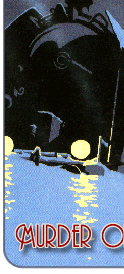
82 Years ago on 1st January 1934 Agatha Christie's most famous book was published.
Christie takes the locked room problem to another level. The murderer can only be one of the passengers on a snow bound train. But who ?

Agatha Christie |
Murder on the Orient Express |
Literary significance and reception In The New York Times Book Review of March 4, 1934, Isaac Anderson finished by saying, "The great Belgian' detective's guesses are more than shrewd; they are positively miraculous. Although both the murder plot and the solution verge upon the impossible, Agatha Christie has contrived to make them appear quite convincing for the time being, and what more than that can a mystery addict desire?" The reviewer in The Guardian of January 12, 1934 stated that the murder would have been “perfect” had Poirot not been on the train and also overheard a conversation between Miss Devonham [sic] and Colonel Arbuthnot before he boarded, however, "'The little grey cells' worked admirably, and the solution surprised their owner as much as it may well surprise the reader, for the secret is well kept and the manner of the telling is in Mrs. Christie’s usual admirable manner.”[8] Robert Barnard: "The best of the railway stories. The Orient Express, snowed up in Yugoslavia, provides the ideal 'closed' set-up for a classic-style exercise in detection, as well as an excuse for an international cast-list. Contains my favourite line in all Christie: 'Poor creature, she's a Swede.' Impeccably clued, with a clever use of the Cyrillic alphabet (cf. The Double Clue). The solution raised the ire of Raymond Chandler, but won't bother anyone who doesn't insist his detective fiction mirror real-life crime." References and AllusionsReferences to actual history, geography and current science Another, less-remembered, real-life event also helped inspire the novel. Agatha Christie first travelled on the Orient Express in the fall of 1928. Just a few months later, in February 1929, an Orient Express train was trapped by a blizzard near Cherkeskoy, Turkey, remaining marooned for six days. Christie herself was involved in a similar incident in December 1931 while returning from a visit to her husband's archaeological dig at Nineveh. The Orient Express train she was on was stuck for twenty-four hours, due to rainfall, flooding and sections of the track being washed away. Her authorised biography quotes in full a letter to her husband detailing the event. The letter includes descriptions of some passengers on the train, who influenced the plot and characters of the book: in particular an American lady, Mrs. Hilton, who was the inspiration for Mrs. Hubbard. |